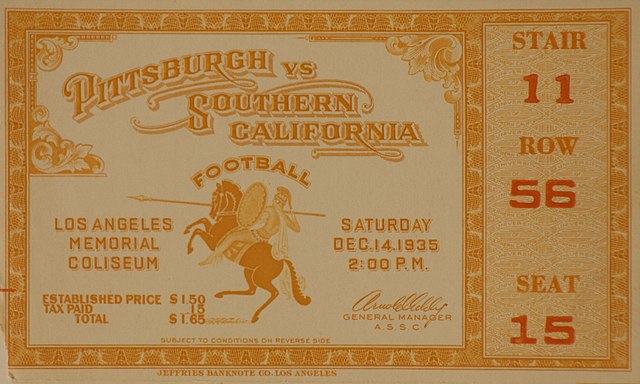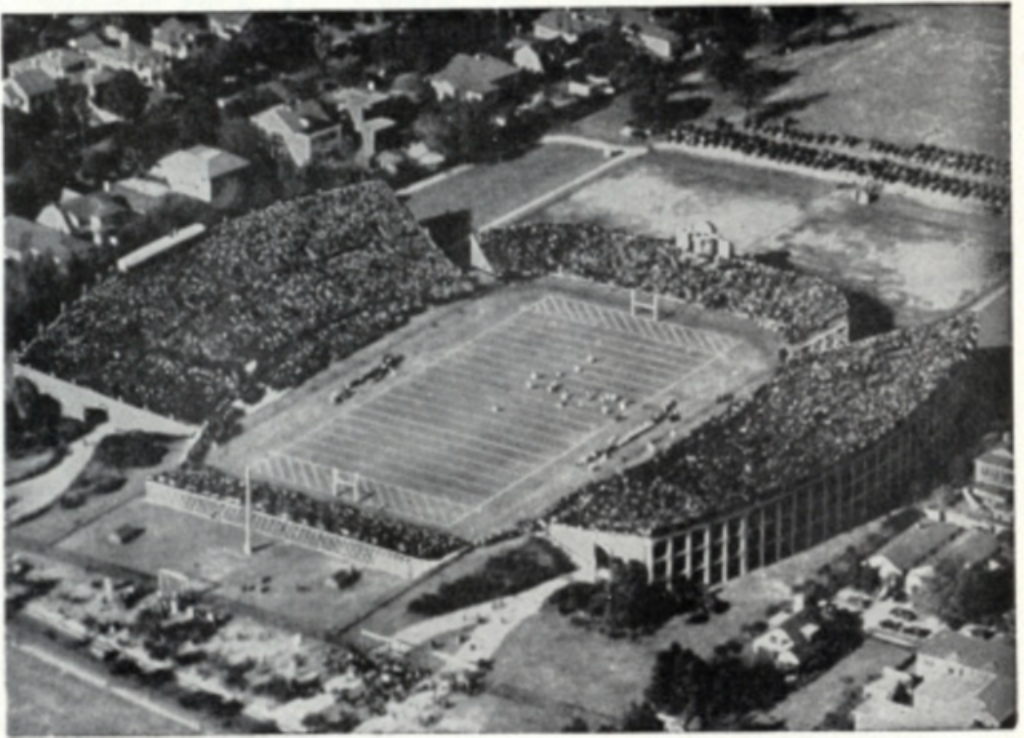In this edition, we talk about the history of College Football in 1935. The Football History Rewind Series Part 76, goes through the big games, the star players, and the top teams of the season.
The 1935 College Football Season
Introduction to 1935 College Football
The 1935 College Football Season is one to look back upon as one of the greatest in the sport's history. There was controversy on who the top team was, many official ways to measure a champion, and a new award that would recognize the nation's top player.

Please sit back and enjoy out glimpse back in history at this memorable season.
Defending Champs were strong contenders in 1935
The 1934 consesus champions were the Minnesota Golden Gophers, and their Future Hall of Fame coach, Bernie Bierman, once again had a formidable roster, that made them an odds on favorite to repeat.
The 1935 Gophers featured left end Dwight T. Reed, star right end Ray King, Guard Bud Wilkinson, Tackle Ed Widseth, Halfback Sheldon Beise, Tackle Dick Smith, quarterback Babe LeVoir and high caliber back George Roscoe. Minnesota opened its season with a 26–6 victory over North Dakota Agricultural before a crowd of more than 34,000 at Memorial Stadium in Minneapolis. Minnesota scored four touchdowns, two by Reed, one being a 40-yard pass from halfback Roscoe. George Roscoe also tallied on a four-yard run King on a 17-yard pass from Roscoe.
Their second test was to travel to Nebraska and play a highly touted Cornhuskers team. The Gophers escaped with the thrilling 12-7 victory there. Minnesota's march towards greatness continued with wins over Tulane (20-0), Northwestern (21-13), Purdue (29-7), at Iowa 13-6, Michigan (40-0), and finally a 33-7 one-sided win over Wisconsin at home. The Golden Gophers compiled an undefeated 8–0 record and outscored their opponents by a combined total of 194 to 36.
At the end of the season, the team's awards came rolling in. Quarterback Babe LeVoir earned the team's most valuable player award. Tackle Ed Widseth was named an All-American by the Walter Camp Football Foundation, UPI, Liberty, Hearst, and New York World-Telegram. Beise, quarterback LeVoir, Smith, Widseth, and Wilkinson were named All-Big Ten. Guard Bud Wilkinson was named All-American by Grantland Rice and the Associated Press. Tackle Dick Smith was named an All-American by the AP, UPI, New York World-Telegram, and Look Magazine. Halfback Sheldon Beise was named an All-American by the American Sports Service and New York Daily Mirror.
The Mustangs were Bucking for a Title Run too
Down near Dallas, Texas the Southern Methodist University team was also fielding a championship caliber club. In his first season at the school, Head Coach Matty Bell led a strong roster of stars. Leading the way to a promising season were Halfback Bob Wilson, Tackle Truman Spain, Harry Shuford, Marco Stewart, and Guard J. C. Wetsel.
The SMU Mustangs went on to an overall mark of 12–1 on the season with an unblemished of 6–0 record in conference play, winning the SWC title.
The Mustangs had convincing winds over, North Texas State (39-0), Austin (60-0), Tulsa (20-0), Washington University 35-6, Rice (10-0), Hardin-Simmons (18-6), Texas (20-0), UCLA (21-0) in LA, Arkansas (17-6), Baylor (10-0), TCU (20-14),and Texas A&M (24-0).
The Mustang's only set back was a 0-7 loss in the Rose Bowl on New year's Day at the hands of Stanford.
Rating Systems for Determining a National Champ
The 1935 college football season was the end of an era. The short but sweet time frame in collegiate football before polls set the stage for determining a National Champion.
Since 1924 football has relied on the Dickinson System to help calibrate the field of contenders into a mathematical, ranked order. There were flaws in it, and by 1935, the NCAA recognized six systems of equation theory.
- Dickinson System - run by the University of Illinois Professor Frank Dickinson
- Houlgate System - Created by Carroll Everard "Deke" Houlgate Sr., and was more formally known as the Deke Houlgate collegiate football rating system. This mathematical rating system would determine annual collegiate gridiron champions by rating teams according to the strength of their opponents and how they fared against them.
- Boand System (Also known as Azzi Ratem System) - developed by William F. Boand. The rankings were based on mathematical formula. This system was used from 1930 through 1960 for contemporary selections, but also did a retroactive study back through the 1924 season to calculate champions for those past years as well.
- Litkenhous Difference by Score Ratings System - This mathematical system was used to rank football and basketball teams, based on the score differential of common opponents and opponents in general during a season. The Litrating system was developed by Vanderbilt University professor Edward E. Litkenhous and his brother, Francis H. Litkenhous.
- Poling math rating system - A mathematical rating system for college football teams developed by Richard Poling from Mansfield, Ohio. Poling was a former football player at Ohio Wesleyan. Poling's football ratings were published annually in the Football Review Supplement and in various newspapers. Predated national champions from 1924-34.
- Dunkel System - This system started in 1929 and still used today, was a power index system devised by Dick Dunkel Sr.and later revised by his son, by Dick Dunkel Jr. (1972-95); and later by John Duck (1996-present), According to the official website at www.dunkelindex.com, Because teams back then rarely traveled across the country to play each other, there was a constant debate between the East and West coasts over who was Number 1. Dick came up with an ingenious solution: take what data is available, create some formulas and calculate mathematically the best teams in the land. It was an idea that soon took off.
Dick took some scratches on index cards and turned it into a system that was syndicated nationwide. Because of its novel approach and unparalleled accuracy, the Dunkel Index quickly became the de facto authority on college football. Hundreds of newspapers around the country carried the Dunkel Index and Dick continued to produce these power ratings by hand until the early 1970s.
- Williamson System - Started in 1932 and going through 1963 this system was a power rating system chosen by Paul Williamson of New Orleans, Louisiana, a geologist and member of the Sugar Bowl committee .
The Contenders for the 1935 Mythical Title
Here is how the recognized entities saw the best team in the nation of 1935:
- The UPI conducted a poll of sportswriters from 112 newspapers, and they voted Minnesota #1 and SMU #2 at the end of the regular season.
- SMU won the coveted the Knute Rockne Trophy and the moniker of "National Champion" according to the Dickinson Rating System. But Dickinson only looked at the regular season and not at the post season Rose Bowl loss.
- The Houlgate System, selected SMU.
- The Boand, Litkenhous and Poling Systems all chose Minnesota.
- The Dunkel System selected Princeton as its top team.
- The Williamson System placed Texas Christian University as the top team.
Others in contention were:
12-1 Texas Christian , but that one loss of TCU as mentioned earlier was at the hands of SMU.
Ohio State at 7-1. Thie late season , late game loss to Notre Dame in a legendary 4th quarter comeback by the Irish sealed their fate, and a tie for Big Ten Supremacy with the Gophers.
The Cal Golden Bears ended with a loss to Stanford and a 9-1 record, missing out on a trip to the Rose Bowl.
7-1-1 Notre Dame, who lost the lowly Northwestern and tied Army.
UCLA finished 8-2, but the home loss to SMU and defeat at the hands of Cal, overshadowed their win over Stanford.
Holy Cross was 9-0-1, but their competition level was considered weak.
The University of Ohio finished 8-0 with a signature win over Illinois but barely got by some weaker teams on the schedule.
Other Bowl Games
The Sugar Bowl had its second season and invited TCU (11–1) against Southeastern Conference champion LSU (9–1). In front of a great crowd of over 38,000 fans, TCU's Sammy Baugh was forced out of the end zone on a pass attempt, to score a safety providing LSU with a 2–0 late lead after a mostly stalemate game earlier. Two minutes later, Baugh drove the Frogs to the 17-yard line, setting up Taldon Malton's field goal. The final score was TCU 3, LSU 2.
In Miami, the second annual Orange Bowl matched Ole Miss (9–2) against unheralded Catholic University (8–1). A crowd of 10,000 watched Catholic take an early lead and pull off a 20–19 upset.
The Sun Bowl matched two colleges for the first time, as New Mexico A&M and Hardin–Simmons battled to a 14–14 tie.

1935 All-America Team
According to the Sport-Reference.com the 1935 All-America Team was as follows:
Player Pos
- Jay Berwanger B Chicago 119 Att, 477 Yds, 4.0 Avg
- Bobby Grayson B Stanford
- Riley Smith B Alabama
- Bobby Wilson B SMU
- Wayne Millner E Notre Dame
- James Moscrip E Stanford
- Gaynell Tinsley E LSU
- Gomer Jones L Ohio State
- Darrell Lester L TCU
- Larry Lutz L California
- Sidney Wagner L Michigan State
- John Weller L Princeton
- JC Wetsel L SMU
- Ed Widseth L Minnesota
Conclusion
Special thanks to Wikimedia Commons for the images above:
- Aerial view of the Sugar Bowl held on January 1, 1935.
- December 14, 1935 ticket stub for the USC versus Pittsburgh football game
Also information was gleaned from TipTop25.com. Wikipedia.com, Sports-Reference.com, and Newspapers.com






